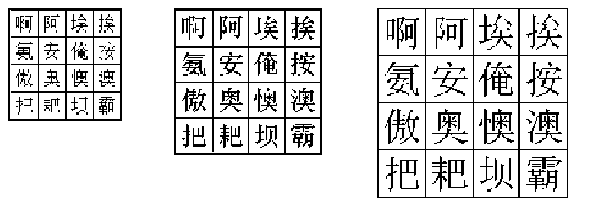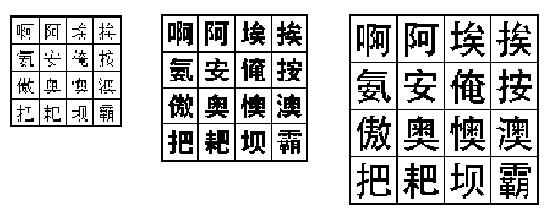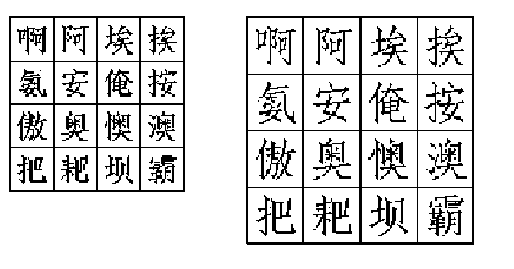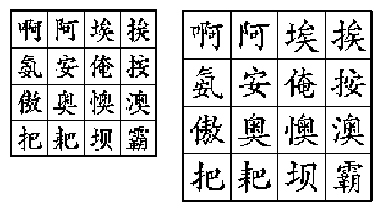
DECwindows Motif provides Chinese DECwindows fonts in various sizes and typefaces for 75 dpi (dot-per-inch) display devices. Table 4-1 lists the screen fonts for Simplified Chinese.
| Typeface | Glyph Size | Bounding Box | Remarks |
|---|---|---|---|
| Screen | 15 x 16* | 16 x 18 | Mandatory font, defined in GB5199.1-85 |
| 22 x 22* | 24 x 24 | Mandatory font | |
| Songti | 15 x 16* | 16 x 16 | Optional font, defined in GB5199.1-85 |
| 22 x 22* | 24 x 24 | Optional font | |
| 32 x 32* | 34 x 34 | Optional font, defined in GB6345.1-86 | |
| Heiti | 15 x 16 | 16 x 16 | Optional font |
| 22 x 22* | 24 x 24 | Optional font | |
| 32 x 32* | 34 x 34 | Optional font, defined in GB12036-89 | |
| Fangsongti | 22 x 22* | 24 x 24 | Optional font |
| 32 x 32* | 34 x 34 | Optional font, defined in GB12034-89 | |
| Kaiti | 22 x 22* | 24 x 24 | Optional font |
| 32 x 32* | 34 x 34 | Optional font, defined in GB12035-89 |
Note
The fonts marked with an asterisk are supplied by China Standard Technology Development Corporation (CSTDC) of People's Republic of China.
In addition to these Chinese fonts, several miscellaneous screen fonts are also provided for use in Hanzi DECterm and the Motif toolkit.
No 100 dpi Chinese fonts are provided in the kit. To allow you to use the Chinese fonts on 100 dpi display devices, a font alias file is provided to map the 75 dpi font names to 100 dpi font names.
You must specify the DECwindows font names in X Logical Font Description (XLFD) format in your application programs or in the application resource files. You can specify wildcards "*" for any fields in the font names.
You can use the following font names for both 75 dpi and 100 dpi display devices. If you want to state the display resolution explicitly, you can specify 75 or 100 in the X- and Y-resolution fields, that is, the second and third asterisks in the following XLFD names.
-ADECW-Screen-Medium-R-Normal--*-180-*-*-M-160-GB2312.1980-1
-ADECW-Screen-Medium-R-Normal--*-240-*-*-M-240-GB2312.1980-1
-ADECW-Songti-Medium-R-Normal--*-160-*-*-M-160-GB2312.1980-1
-ADECW-Songti-Medium-R-Normal--*-240-*-*-M-240-GB2312.1980-1
-ADECW-Songti-Medium-R-Normal--*-340-*-*-M-340-GB2312.1980-1
-ADECW-Heiti-Medium-R-Normal--*-160-*-*-M-160-GB2312.1980-1
-ADECW-Heiti-Medium-R-Normal--*-240-*-*-M-240-GB2312.1980-1
-ADECW-Heiti-Medium-R-Normal--*-340-*-*-M-340-GB2312.1980-1
-ADECW-Fangsongti-Medium-R-Normal--*-240-*-*-M-240-GB2312.1980-1
-ADECW-Fangsongti-Medium-R-Normal--*-340-*-*-M-340-GB2312.1980-1
-ADECW-Kaiti-Medium-R-Normal--*-240-*-*-M-240-GB2312.1980-1
-ADECW-Kaiti-Medium-R-Normal--*-340-*-*-M-340-GB2312.1980-1
Table 4-2 shows the font names, in XLFD format, of several miscellaneous Chinese screen fonts.
| XLFD Font Name | Character Set |
|---|---|
| -ADECW-Screen-Medium-R-Normal--*-180-*-*-M-80-ISO8859-1 | ISO Latin-1 |
| -ADECW-Screen-Medium-R-Normal--*-180-*-*-M-80-DEC-DECctrl | DEC Display Control |
| -ADECW-Screen-Medium-R-Normal--*-180-*-*-M-80-DEC-DECsuppl | DEC Supplemental |
| -ADECW-Screen-Medium-R-Normal--*-180-*-*-M-80-DEC-DECtech | DEC Technical |
| -ADECW-Screen-Medium-R-Normal--*-180-*-*-M-80-DEC-DRCS | DEC DRCS |
| -ADECW-Screen-Medium-R-Normal--*-240-*-*-M-120-ISO8859-1 | ISO Latin-1 |
| -ADECW-Screen-Medium-R-Normal--*-240-*-*-M-120-DEC-DECctrl | DEC Display Control |
| -ADECW-Screen-Medium-R-Normal--*-240-*-*-M-120-DEC-DECsuppl | DEC Supplemental |
| -ADECW-Screen-Medium-R-Normal--*-240-*-*-M-120-DEC-DECtech | DEC Technical |
| -ADECW-Screen-Medium-R-Normal--*-240-*-*-M-120-DEC-DRCS | DEC DRCS |
Figure 4-1 through Figure 4-4 illustrate samples of Chinese fonts.
Figure 4-1. Songti Font Sample

Figure 4-2. Heiti Font Sample

Figure 4-3. Fangsongti Font Sample

Figure 4-4. Kaiti Font Sample

For Simplified Chinese, the X Window System defines two encodings for the GB2312-80 character set as shown in Table 4-3. Figure 4-5 illustrates the GB2312-80 encoding scheme.
| Encoding | Character Set Registry |
|---|---|
| GL | GB2312.1980-0 |
| GR | GB2312.1980-1 |
Figure 4-5. GB2312-80 Font Encoding Schemes
| Second Byte | |||||
| 00 | 20 | 80 | A0 | FF | |
| First Byte |
20 | ||||
| 80 | GB2312.1980-0 | ||||
| A0 | |||||
| FF | GB2312.1980-1 | ||||
Vendors may adopt different encoding schemes or even different character sets to produce their fonts. The Chinese DECwindows fonts supplied by DECwindows Motif are all in GR encoding. To allow you to run applications on third-party workstations on which only GL-encoded fonts are installed, the DECwindows implementation of X11R6 Xlib supports the conversion of GR encoding to GL encoding for text drawing and measurement, as shown in Table 4-4.
| Convert From | Convert To |
|---|---|
| gb2312.1980-1 | gb2312.1980-0 |
Table 4-5 shows the default fonts used in the Motif Toolkit:
| XLFD Font Name | Character Set |
|---|---|
| -ADECW-Screen-Medium-R-Normal--*-180-*-*-M-80-iso8859-1 | ISO8859-1 |
| -ADECW-Screen-Medium-R-Normal--*-180-*-*-M-160-GB2312.1980-1 | GB2312.1980-1 |
| -ADECW-Screen-Medium-R-Normal--*-180-*-*-M-160-GB2312.1980-UDC | GB2312.1980-UDC |
| -ADECW-Screen-Medium-R-Normal--*-180-*-*-*-*-* | Fontset |
To override the default fonts of a Simplified Chinese DECwindows application, you should specify the ISO Latin-1, GB2312-80 and extended GB (UDC) fonts as well as the Chinese fontset when creating widget instances.